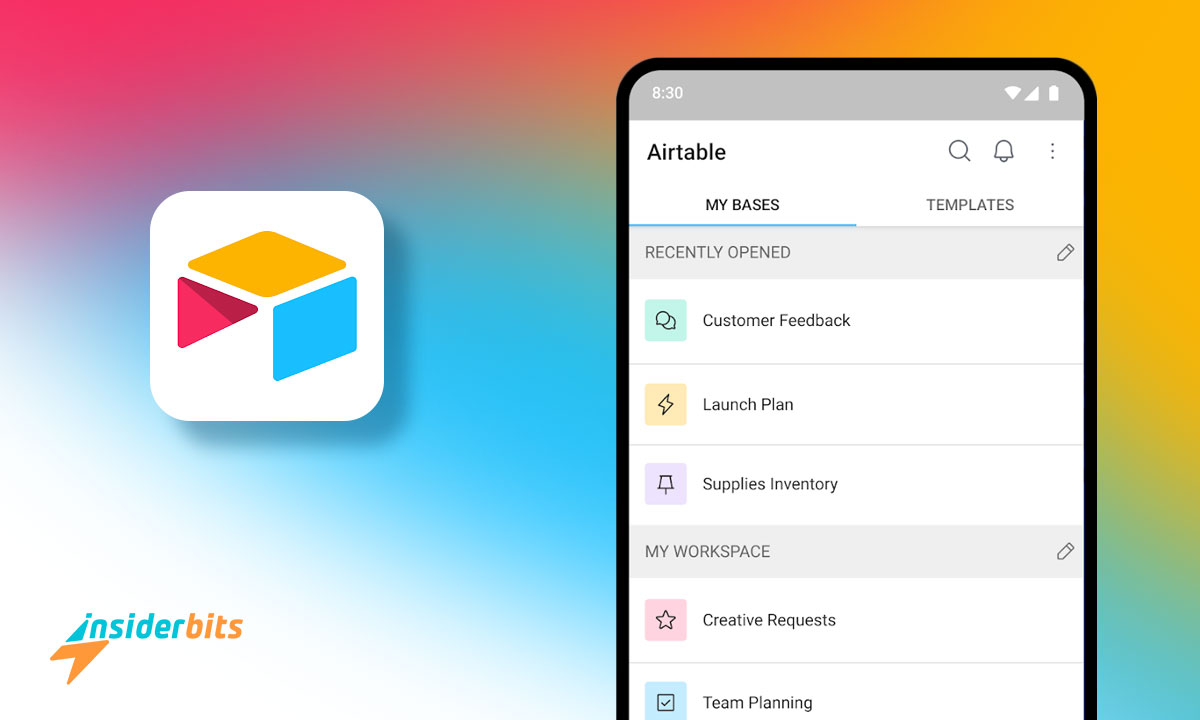AirTable, a powerful cloud-based platform, offers a versatile tool for streamlining workflows and enhancing productivity.
With its custom app feature, users can create tailored solutions that cater to their specific business needs, ensuring seamless integration and efficient operations.
In this article, Insiderbits will explore the benefits and capabilities of AirTable’s custom app, highlighting how it can be leveraged to optimize your workflow and drive success.
AirTable Custom App – Review:
Interface Designer
Airtable’s interface designer feature allows users to create custom interfaces by pulling in existing data from their base and customizing the layout to their needs. This can be done with simple drag-and-drop functionality, requiring no technical knowledge. This flexibility is particularly useful for creating custom dashboards and interfaces that fit specific use cases, such as content reviews.
Team Collaboration Tools
Airtable offers basic but decent collaboration features. Users can invite team members to their base and assign them different levels of access. Communication within a team is facilitated through commenting on records and mentioning team members. However, for projects that rely heavily on collaboration and extensive communication, other apps like ClickUp or monday.com might be more suitable.
Automation
Airtable’s automations are based on a trigger-and-action model. Users can build automation within their base or integrate with third-party apps like Google Workspace, Google Drive, and Outlook. The number of automations that can be run per month depends on the chosen plan. For complex projects or more automation flexibility, users can also write their own formulas on Airtable.
Key Features
Airtable offers a range of features, including Kanban boards, lists, calendars, timelines, spreadsheet views, Gantt charts, workload planning, long-term planning, multiple project management, dependency management, native scrum management, set user permissions, file storage, time-tracking, built-in integrations, and reporting features.
User-Friendliness
Airtable’s user interface is well-known for its user-friendliness and intuitive design. The colorful scheme and customization options add to the overall enjoyable user experience. Airtable stands out among other database management platforms for its ease of use, making it accessible to users who are new to database tools.
Pricing and Plans
Airtable offers a free plan with no limits on the number of bases, collaboration with other users, and access to some of the best features. Paid plans include the Pro Plan at $20 per user per month, which offers more advanced features and integrations. However, the workspace model can be limiting for organizations, as it requires paying per user per upgraded workspace, which can unexpectedly drive up costs.
AirTable Customization Tips:
Utilize the Interface Designer: Take advantage of Airtable’s drag-and-drop interface designer to create custom layouts that suit your specific needs. Experiment with different views, such as Kanban boards, calendars, or Gantt charts, to find the most effective way to visualize your data.
Optimize Automation: Set up automation to streamline repetitive tasks and save time. Explore the various triggers and actions available in Airtable’s automation builder to create workflows that fit your specific use case. Consider integrating Airtable with other tools, such as Google Workspace or Zapier, to extend the functionality of your custom app.
Leverage Formulas: Use Airtable’s formula language to perform calculations, create conditional formatting, and automate complex tasks. Experiment with different formula functions to extract insights from your data and make informed decisions. Share your custom formulas with other users to promote collaboration and consistency within your team.
Customize Views and Layouts: Create multiple views of your data, such as grids, calendars, or Kanban boards, to suit different user preferences and use cases. Adjust the layout of your views by rearranging, resizing, and hiding fields to focus on the most important information.
Manage User Permissions: Set up user permissions to control access to sensitive information and ensure data integrity. Create different user roles with varying levels of access, such as read-only, editor, or admin, to suit the needs of your team members. Use the “Share” feature to invite collaborators and control their level of access to your custom app.
How to Download AirTable?
To download Airtable on your Android or iOS device, follow these steps:
For Android:
- Go to the Google Play Store on your Android device.
- Type Airtable in the search bar and select the app from the results.
- Tap the Install button to download and install the app.
- Once the installation is complete, tap the Open button to launch the app.
For iOS:
- Go to the App Store on your iOS device.
- Type Airtable in the search bar and select the app from the results.
- Tap the Get button to download the app.
- Tap the Install button to install the app.
- Once the installation is complete, tap the Open button to launch the app.
AirTable Custom App – Customize Your Needs – Conclusion
Airtable’s custom app feature offers a powerful tool for streamlining workflows and enhancing productivity.
With its interface designer, team collaboration tools, automation, and range of features, Airtable is an excellent choice for businesses looking to optimize their workflow and drive success.
While it may have some limitations, particularly in terms of pricing and collaboration, Airtable’s ease of use and customization capabilities make it a valuable tool for many users.
Related: How To Connect Your Apple Devices – A Comprehensive Guide
Like this article? Add the Insiderbits blog to your favorites and visit us whenever you want to learn new and exciting information about technology and much more!





